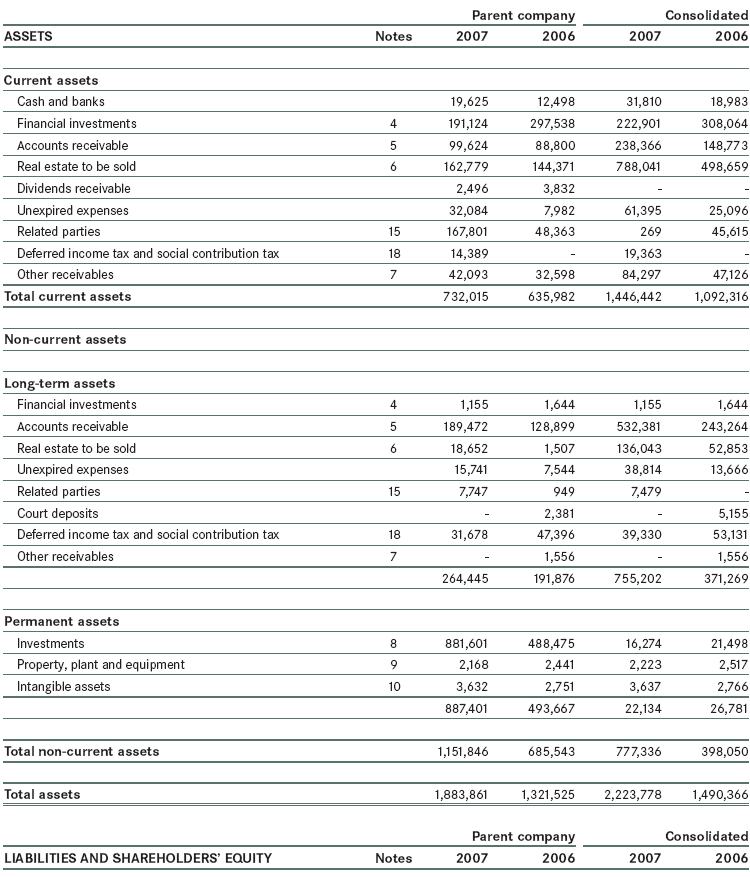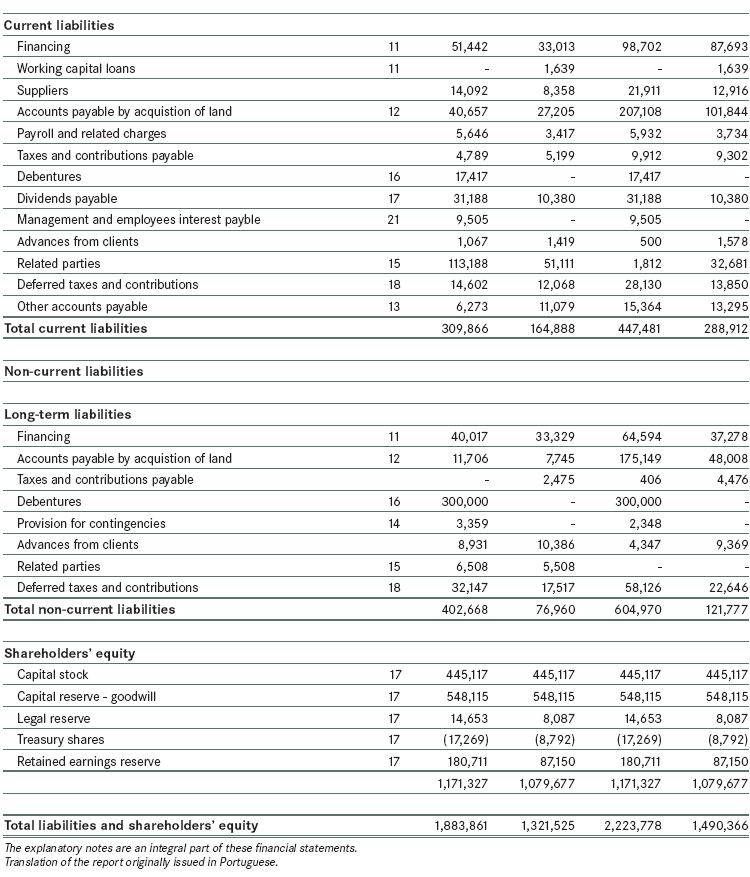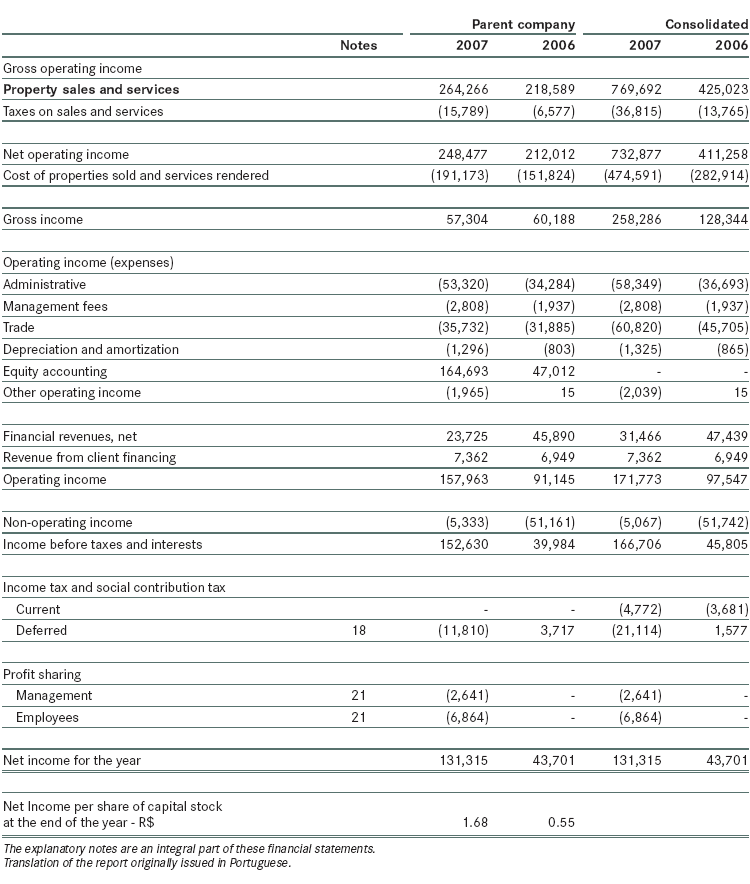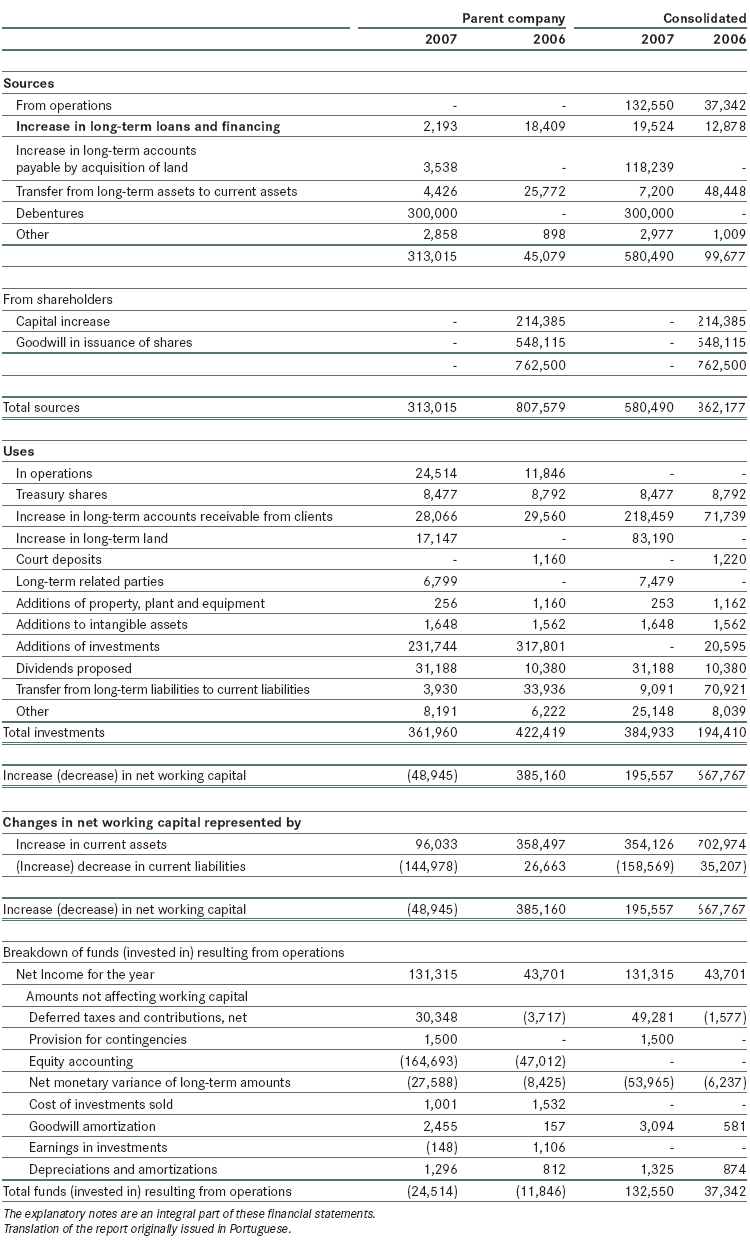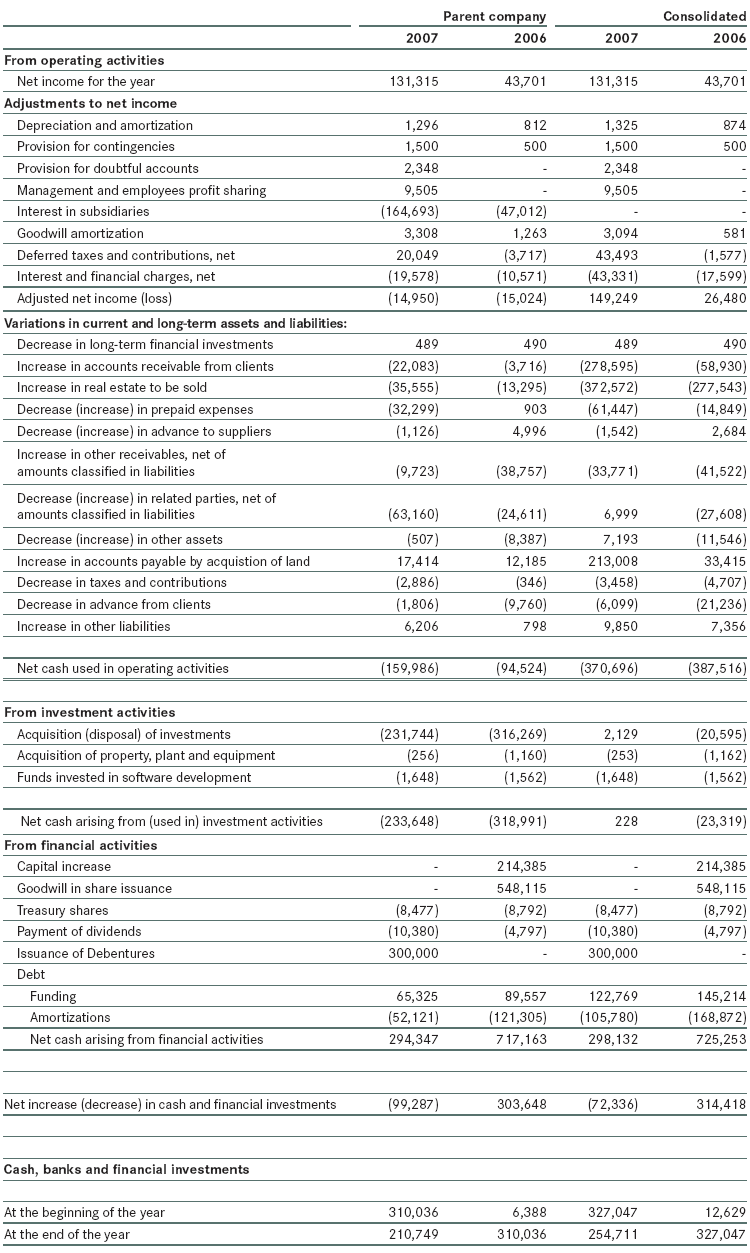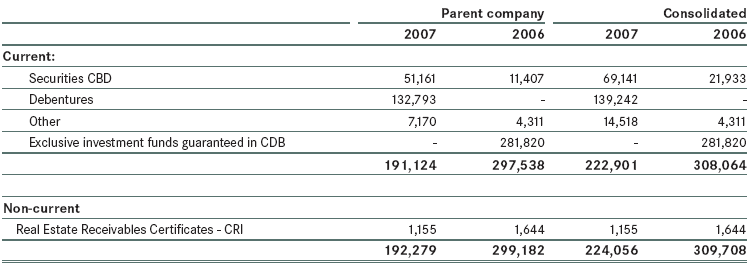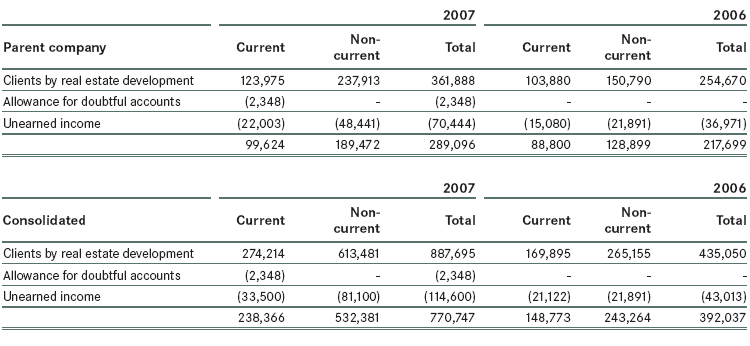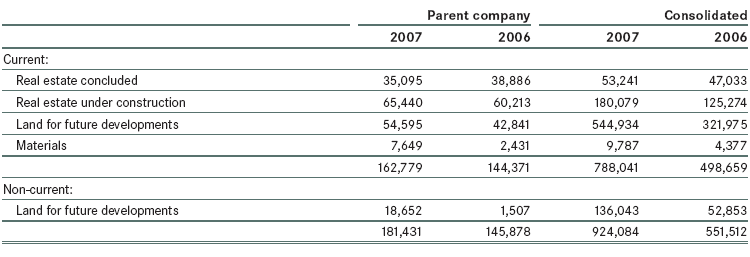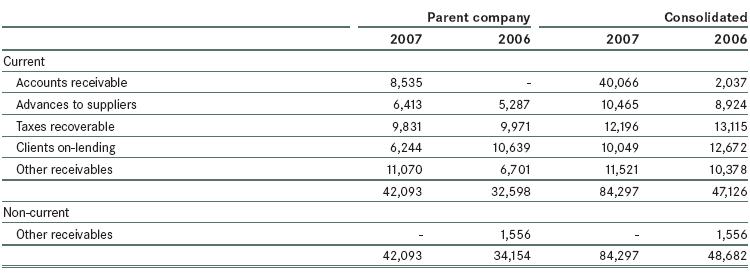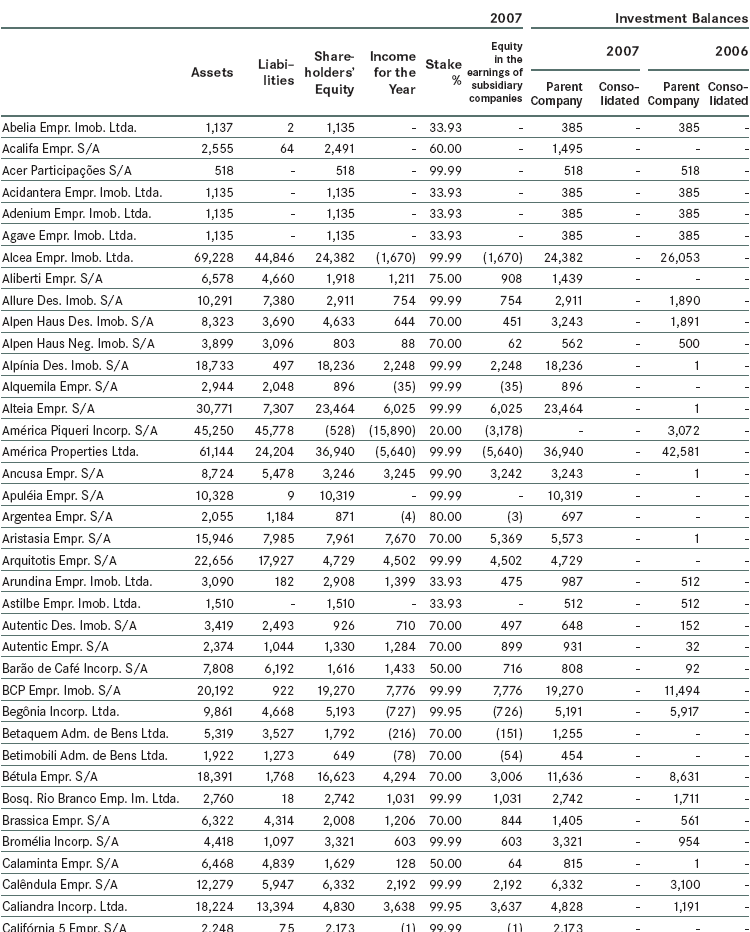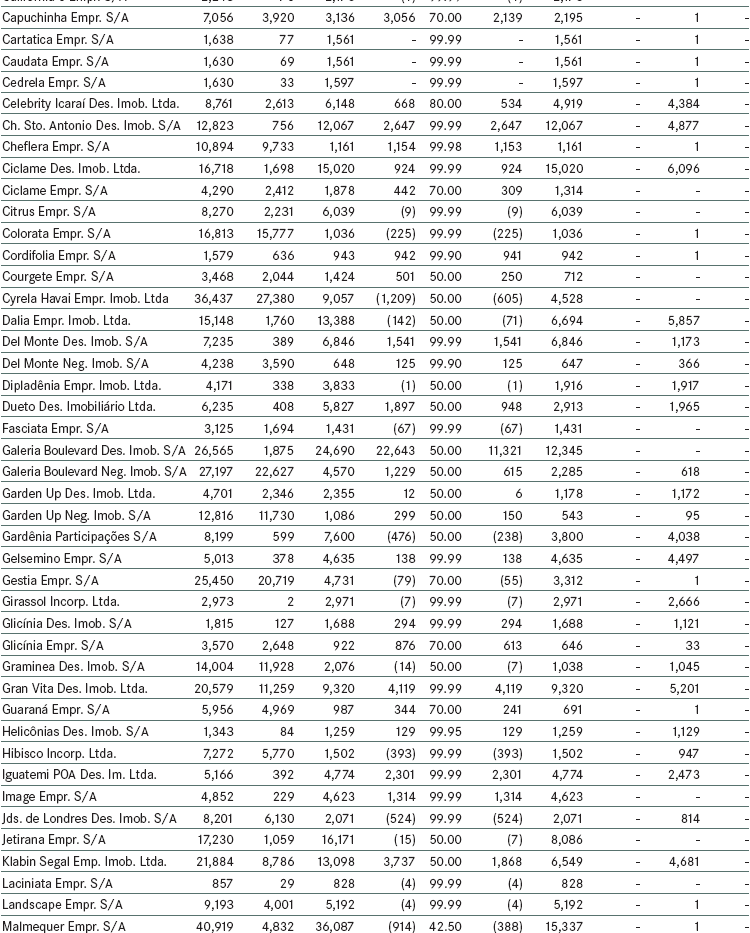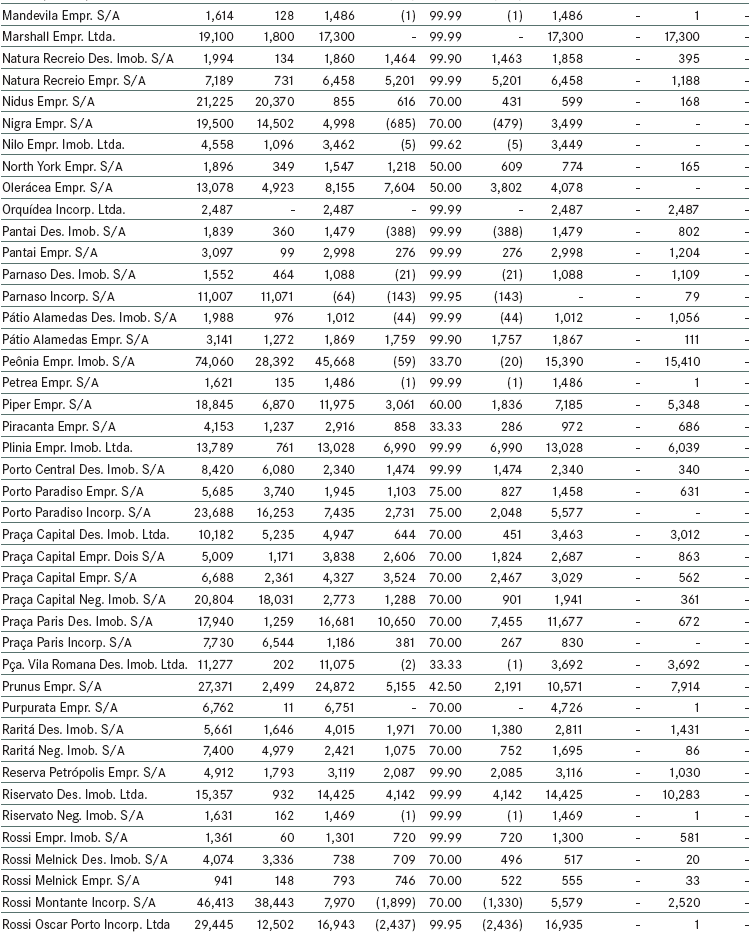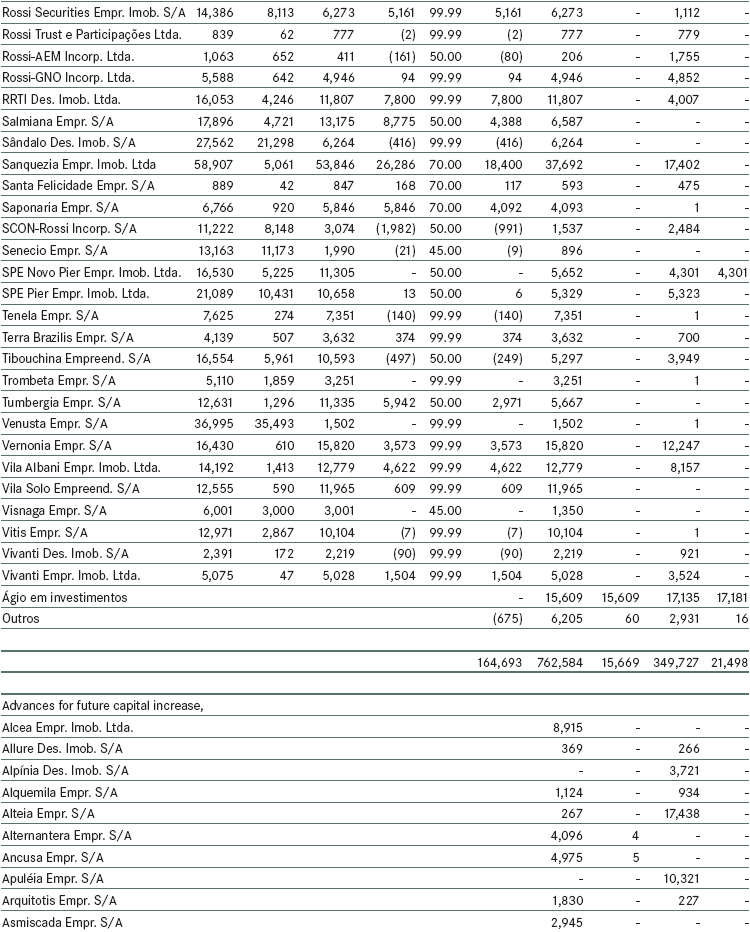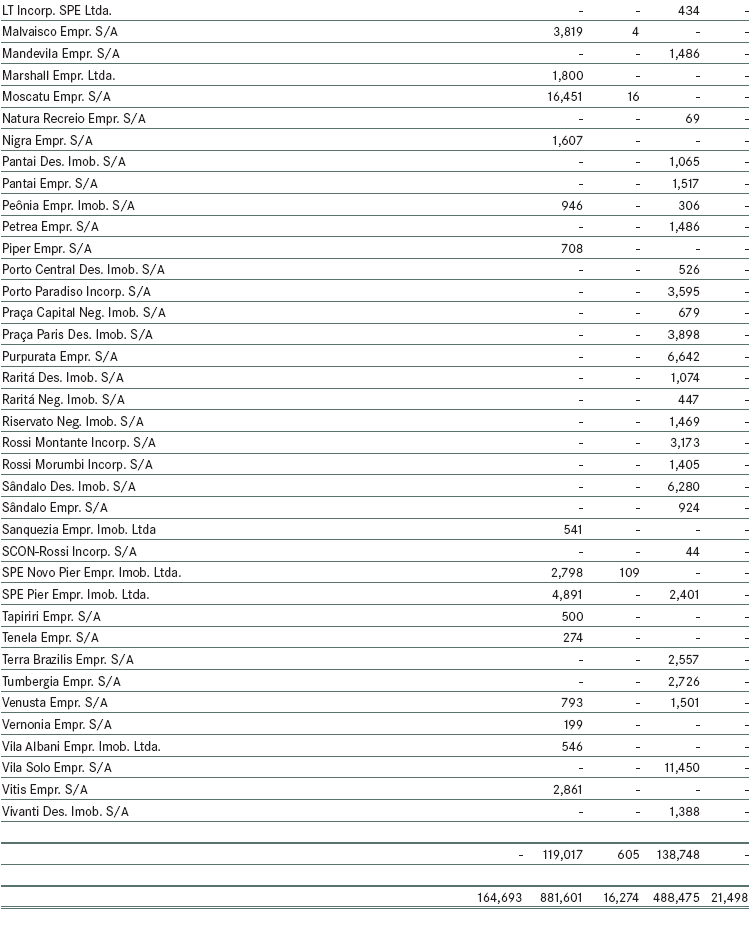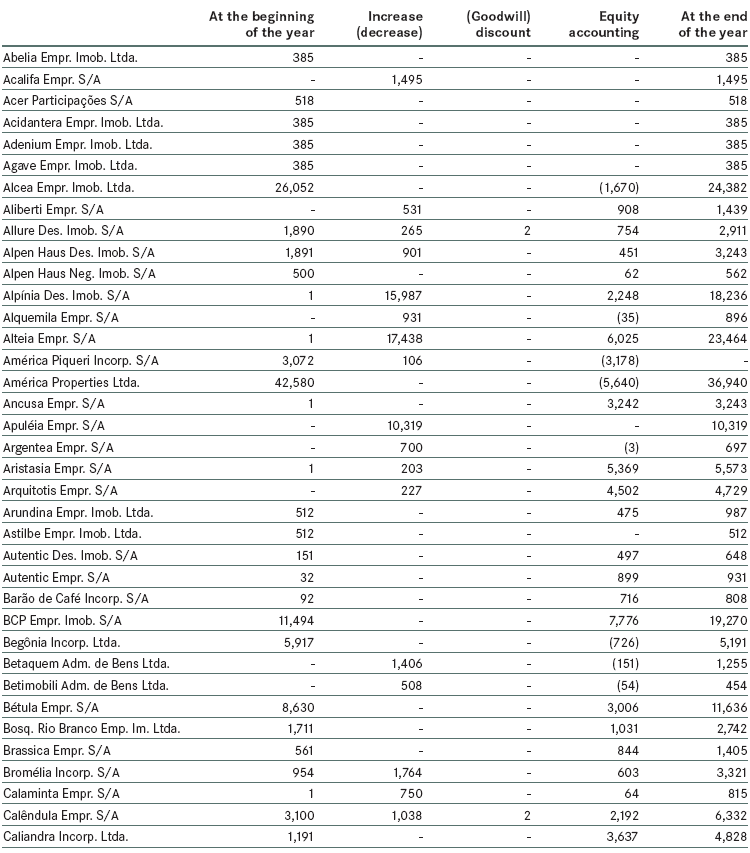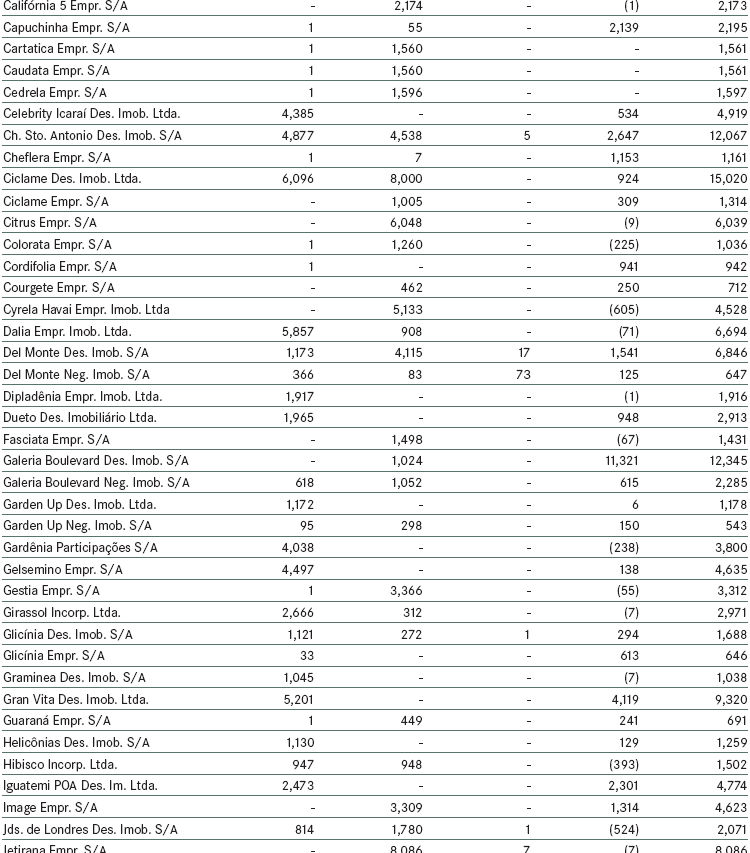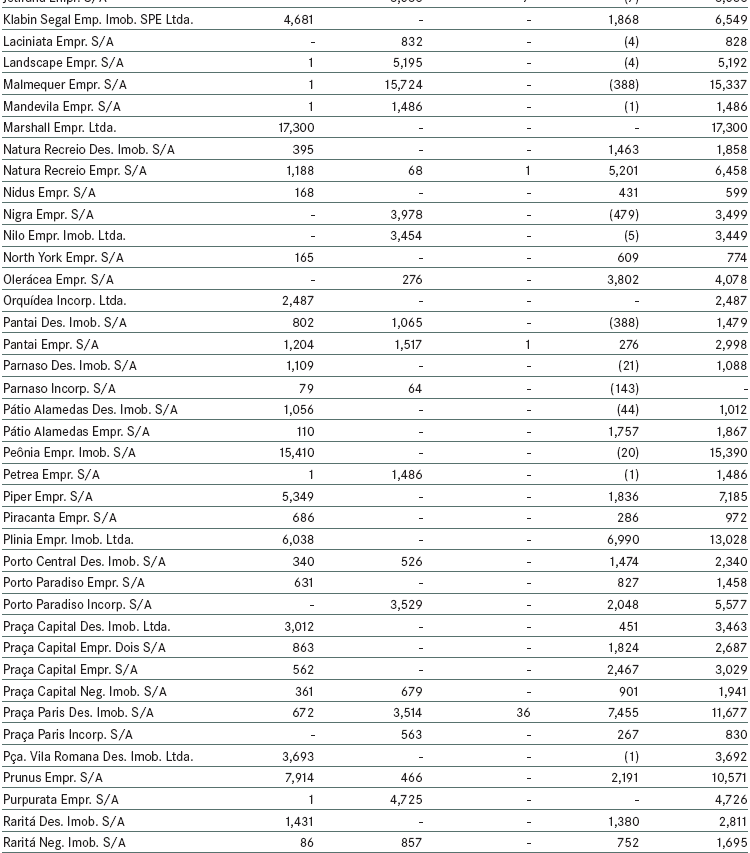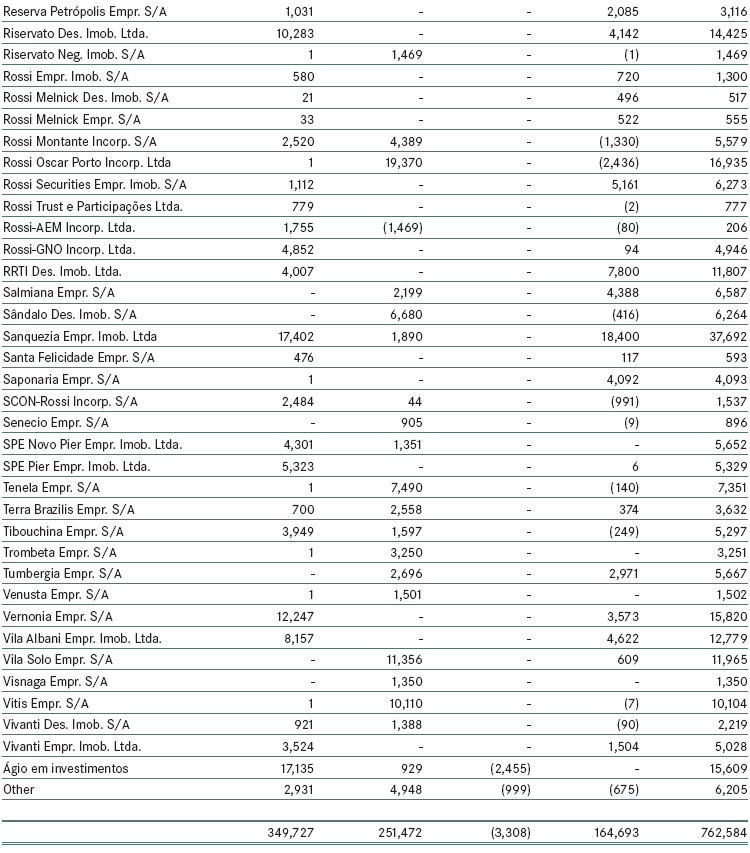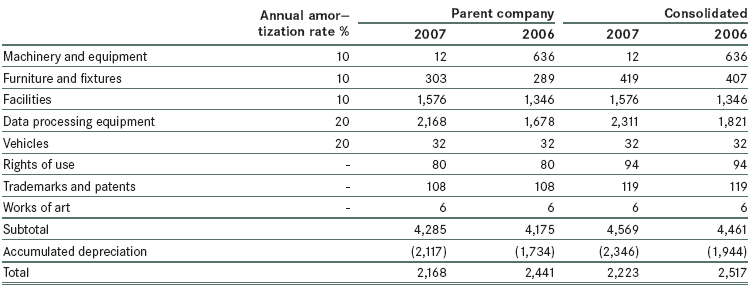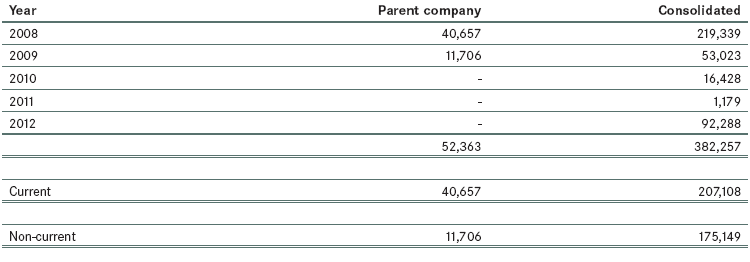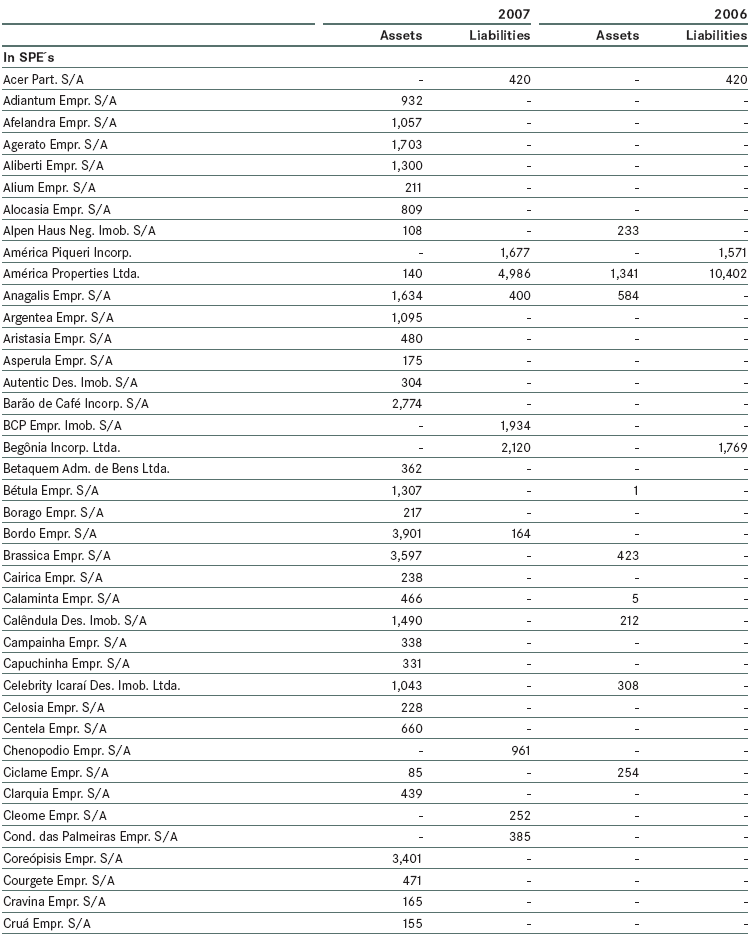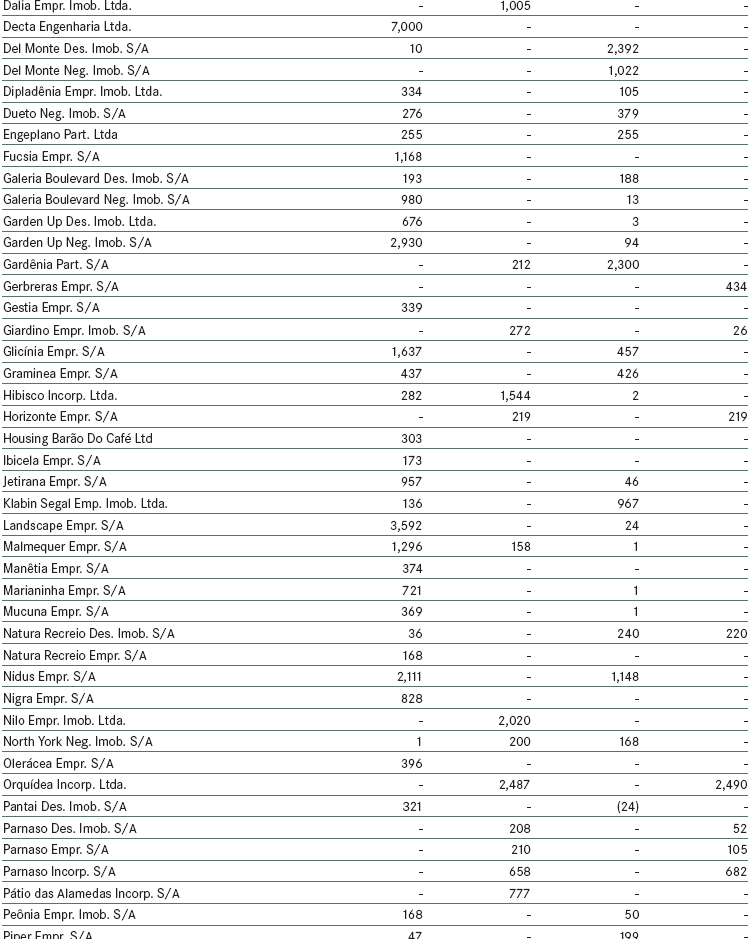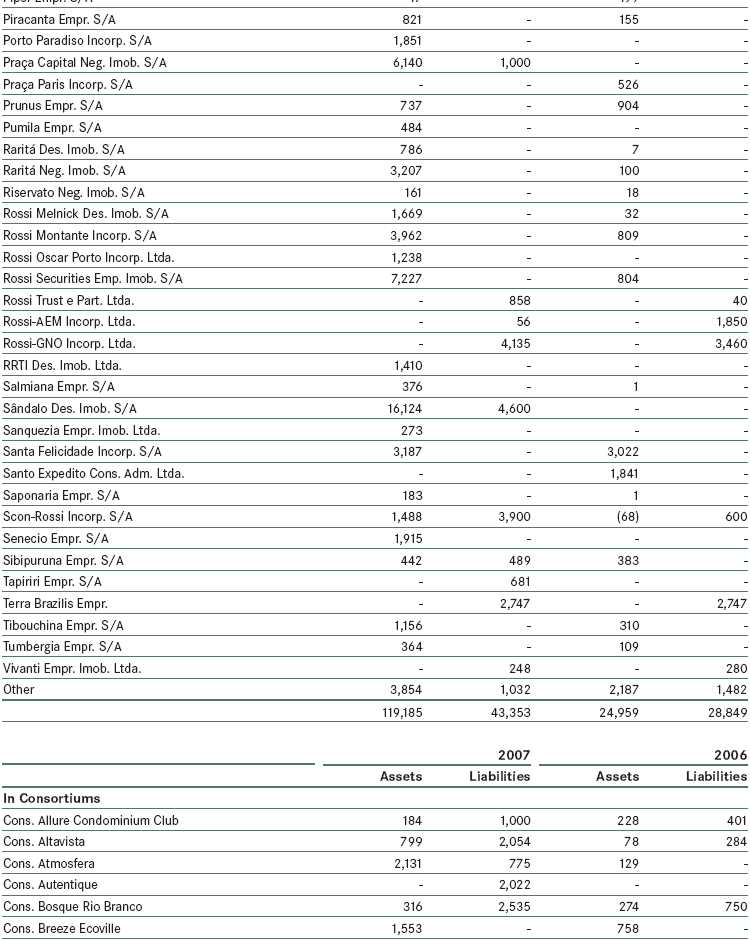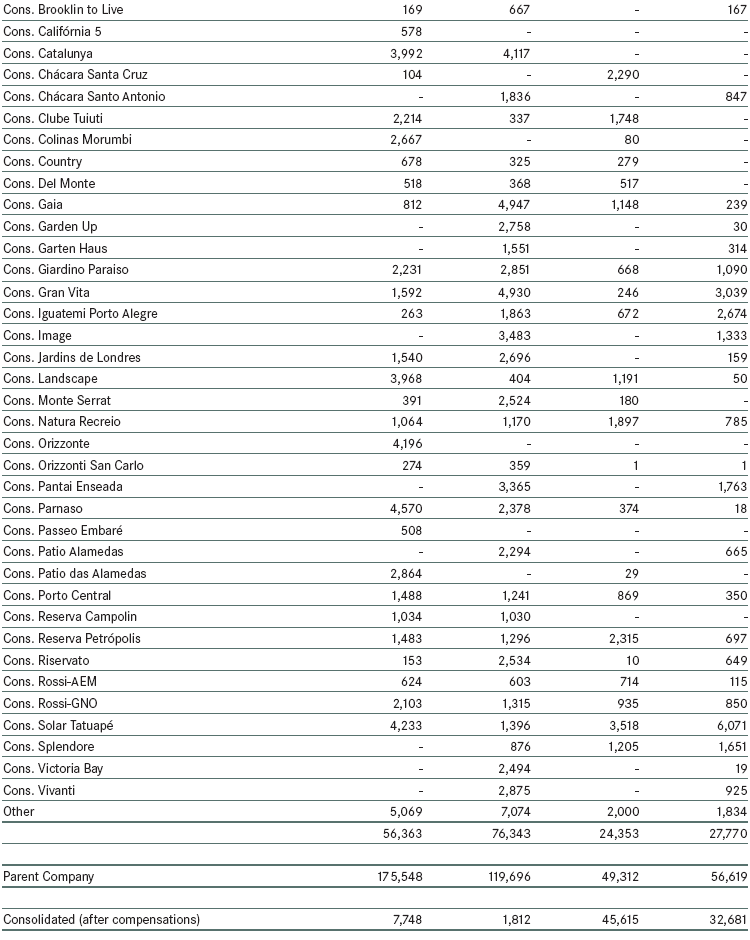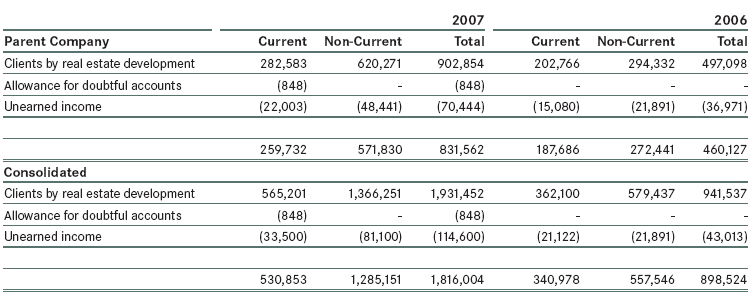|
Rossi Residencial S/A and subsidiaries
Rossi Residencial S/A and subsidiaries
Rossi Residencial S/A and subsidiaries
Rossi Residencial S/A and subsidiaries
Rossi Residencial S/A and subsidiaries
Rossi Residencial S/A and subsidiaries 1. OPERATIONS The operations of Rossi Residencial S/A (Company) comprise the development, building, sale of residential and commercial properties, land subdivision and civil engineering services, through own operations, interest in Special Purpose Entities (SPE) and consortiums. 2. PRESENTATION OF THE FINANCIAL STATEMENTS AND MAIN PRACTICES The financial statements were prepared and presented pursuant to the accounting practices adopted in Brazil, and to the regulations and instructions set forth by the Securities and Exchange Commission of Brazil (CVM). a) Financial investments b) Real estate to be sold c) Allowance for doubtful accounts d) Investments e) Property, plant and equipment f) Intangible assets g) Determination of development income and sale of real estate Pre-fixed interest rates are appropriated to income observing the accrual basis of accounting, regardless of their collection. On sales of housing units not yet concluded, the income is appropriated according to the criteria set forth by Resolution 963/03 of the Federal Accounting Board (CFC), detailed as follows: (i) Costs derived from units sold, including land cost, are fully appropriated to the result; h) Other current and non-current assets and liabilities i) Income tax and social contribution j) Contingent assets and liabilities and legal liabilities k) Accounting estimates Income per share The income per share is calculated based on the number of shares outstanding on the balance sheet dates. l) Cash fl ow statement (supplementary information) 3. CONSOLIDATION CRITERIA The consolidated financial statements were prepared pursuant to the consolidation practices arising from the Brazilian Corporate Law and CVM Instruction 247/96 and comprise Rossi Residencial S/A and investees (individually or under common control, created for the specific purpose of real estate development), listed in Note 8. The accounting practices are consistently applied in all consolidated companies. At the consolidation, investments in Subsidiaries and associated companies, as well as balances receivable and payable, revenues, expenses and unrealized profits resulting from intercompany transactions are eliminated. Considering that the control of investees companies is shared, they are consolidated proportionally. 4. FINANCIAL INVESTMENTS The financial investments represent the amounts invested in private securities (bank deposit certificates and debentures) issued by financial institutions; those having mean return equivalent to 98% - 104% of DI CETIP "CDI". The debentures represent purchase and sale commitments, recorded in CETIP, and are not subject to credit risks of the respective issuers.
5. ACCOUNTS RECEIVABLE These are represented by:
a) Clients by real estate development
b) Unearned income c) Allowance for doubtful accounts The balances receivable considered were those related to conditional sales with guarantees on promissory notes and monetary restatements of overdue accounts receivable. 6. REAL ESTATE TO BE SOLD These are represented by the historical costs of apartments, houses and commercial blocks to be sold, either concluded or under construction, land for future developments and materials to be used in works, distributed as follows:
7. OTHER RECEIVABLES These are represented by:
Related to operations with partners in SPEs (Note 15), the balance of accounts receivable refers to investments carried out in larger amounts than the Company’s interest in the projects, which are offset throughout the execution of said ventures. Clients on-lending refers to funds or amortization to be released derived from bank financings. 8. INVESTIMENTS a) The main investment information on December 31, 2007 is summarized below:
b) In 2007, changes in investments may be presented as follows:
As sociedades de propósitos específicos (SPE) e demais sociedades investidas têm como propósito específico a realização de empreendimentos imobiliários relativos à construção e à comercialização de imóveis residenciais e comerciais, sob modalidade similar à Companhia. 9. PROPERTY, PLANT AND EQUIPMENT This is represented by:
10. INTANGIBLE ASSETS This is represented by:
11. LOANS AND FINANCING This is represented by:
a) Housing credits b) Consolidated schedule of maturities
12. ACCOUNTS PAYABLE BY ACQUISITION OF LAND These refer to acquisitions of land in stock for the real estate development projects, whose disbursement flow is as follows:
Out of a total of R$52,363 (R$382,257 - consolidated), the amount of R$10,206 (R$80,072 - consolidated) shall be paid by means of contribution to development revenues entered in respective land. The remaining R$42,157 (R$302,185 - consolidated) shall be paid in cash, monetarily restated, as per fl ow. These accounts payable are guaranteed by promissory notes, sureties or by the own real estate. 13. OTHER ACCOUNTS PAYABLE These are represented by:
14. PROVISION FOR CONTINGENCIES a) Civil and labor matters b) Tax matters A summary of the constituted provisions and court deposits performed is presented below:
The Company is also involved with other civil and labor proceedings which arose during the normal course of its business, which, in the opinion of the Management and its legal counsels, have an expectation of loss classified as possible. Consequently, no provision was constituted in order to eventually face unfavorable decisions. The amounts of these proceedings, as of December 31, 2007, are: civil R$8,294 and labor R$949. 15. RELATED PARTIES a) Checking accounts with partners in ventures The management structure of these ventures and the cash management are centralized in the company leading the project, which supervises the evolution of the construction works and the budgets, being able to ensure that the necessary investments are made and allocated according to the plan. The changes in financial position of the venture are refl ected in these balances, observing the respective interest percentage, which are not subject to restatement or financial charges and do not have a pre-determined maturity. The average term for the development and conclusion of the ventures in which the funds have been invested is three years, always based on the physical and financial projects and schedules for each work. Thus, the allocation of funds allows the conditions for negotiation settled with each partner and in each of the projects to be concentrated in specific structures, more adequate to its characteristics. The balances are presented as follows:
b) Operations On December 2007, the Company sold real estate units of the Praça Capital project, located in the city of Campinas, to companies owned by controlling shareholders. The total operation amounted to R$2.3 million. The sale value per square meter follows the same conditions as the remaining units of the project traded during the year. These units are leased to the Company for it to operate its branch in the city of Campinas. 16. DEBENTURES On July 25, 2007, the first issuance of thirty thousand (30,000) simple debentures, non convertible into shares, of unsecured type, in a single series, excluding possibilities of renegotiation, with unit face value of ten thousand eighty reais and twentyfour centavos (R$10,080.24), and valid through seven years as of the issuance date, in the total amount of R$302,407, was settled with remuneration that will earn interest equivalent to 106.6% of daily average rates of one day Interbank Deposits (DI) one day, extra-group expressed on a percentage basis per annum (252 business days), calculated and disclosed by CETIP. The debentures yield must be paid on a semiannual basis, and the first maturity date was January 2008, the balance of which on December 31, 2007 amounted to R$17,417, classified under current liabilities. The issuance expenses amounted to R$1,747, recorded in non-operating income. Covenant contractual clauses The private instrument of deed of the first issuance of simple debentures has restrictive clauses determining maximum levels of indebtedness and leverage, as well as minimum levels of coverage of outstanding installments and costs to be incurred. There are other financial commitments in addition to these, among which are:
These contractual clauses were fully complied with in the year ended on December 31, 2007. 17. SHAREHOLDERS’ EQUITY a) Capital stock In the first quarter of 2006, the Company went public by means of the issue of 30,500,000 non-par, registered common shares at an issue value of R$25 per share, of which R$214,385 was destined to capital stock and R$548,115 to capital reserves, in a share premium account. The cost to place these shares on the market was R$49,876, classified under nonoperating expenses. b) Treasury Shares c) Appropriation of the net income for the year
The calculation of proposed dividends corresponding to 2007 is as follows:
The Company’s Board of Directors will propose the Annual General Meeting to approve the allocation of retained earnings, in the amount of R$93,561, to retain profits for reinvestment in its operations, according to the investment plan. 18. DEFERRED TAXES AND CONTRIBUTIONS Deferred taxes and contributions (parent company and consolidated) derive from balances of tax losses and social contribution negative basis, and from temporary non-deductible expenses at assets, and difference in the practice of recognition of profits in the real estate activity for tax purposes (cash basis) and accounting purposes (accrual basis) in liabilities. The management of the Company and of its subsidiaries, based on the future results projections, estimate realization within five years. The balances of assets and liabilities are presented below:
The Company’s management prepared an estimate for the generation of future results, which shall be taxed, based on the expected result of operations, discounted at present value at the rate of 1% per month for the next years. Said technical study is approved by the Executive Board and the Board of Directors and presupposes the realization of deferred income tax and social contribution in the following years:
The amounts of income tax and social contribution stated in the result present the following conciliation in their values at nominal rate:
The Company appropriated R$8,239 (R$22,379 - consolidated) to the 2007 results related to deferred PIS and COFINS. 19. REAL ESTATE DEVELOPMENT AND SALE OPERATIONS The Company and its subsidiaries have adopted the procedures and rules set forth by CFC Resolution no. 963 for accounting recognition of income earned from real estate operations. As a result, the balances of budgeted costs of units sold and the income from unearned real estate sales, in addition to the full balance of accounts receivable from sale agreements, derived from the projects, are not recorded at the financial statements: a) Amounts receivable from clients
b) Costs budgeted to be incurred
c) Income from real estate sales to appropriate
20. FINANCIAL INSTRUMENTS The Company and its subsidiaries participate in operations involving financial instruments with a view to finance its activities or apply its available funds. The management of such risks is carried out by defining conservative strategies, aiming liquidity, profitability and safety. The control policy consists of permanently following-up rates contracted versus those prevailing in the market. Operations involving financial instruments with speculation purposes are not carried out. The financial instruments are recorded in equity accounts and are represented by financial investments (Note 4), accounts receivable from clients (Note 5), loans and financing (Note 11), debentures (Note 16) and treasury shares (Note 17), whose estimated market values are substantially similar to their respective book values. On December 31, 2007, there are no current agreements related to derivative and hedge operations in the Company. 21. EMPLOYEES AND MANAGERS’ PROFIT SHARING Employees’ profit sharing, pursuant to the provisions of the legislation in force, may occur based on spontaneous programs maintained by the companies or in agreements with the employees or union entities and was resolved at a Board of Executive Officers’ meeting. Managers’ profit sharing shall be purpose of resolutions at the General Meeting, pursuant to the provisions in item XV of article 21 of the Company’s Bylaws. Thus, in 2007, the Company provisioned R$9,505 of employees and managers’ profit sharing. 22. INSURANCE The Company and its subsidiaries adopted the policy of taking out insurance coverage for assets subject to risks at amounts deemed as sufficient by the management to cover eventual claims, taking into consideration its activity. The policies are effective and the premiums were duly paid. We consider we have a risk management program with a view to setting out risks, seeking on the market coverage compatible with our size and operations, and our insurance coverage is consistent with other similar sized-companies operating in the industry. Below, the insurance coverage: Engineering risks - (R$758,570) i) Civil liability - coverage for property and bodily damage involuntarily caused to third parties resulting from the execution of work, facilities and setting up at the site, purpose of insurance; Fire - (R$57,569) lightning and explosion at headquarters and regional offices. Building conclusion insurance - (R$115,003) it ensures the surrender of building to committed purchasers. The assumptions of risks adopted, given their nature, are not included in the scope of audit of the financial statements, and therefore they were not audited by our independent auditors. 23. SUBSEQUENT EVENTS a) Changes in the Brazilian Corporate Law Among the amendments required in the accounting practices adopted in Brazil are the following: substitution of the statement of changes in financial position for the statement of cash fl ows, the addition of the value-added statement, the creation of new account subgroups, the segregation of tax and market records and the introduction of new criteria for the classification and assessment of financial instruments, appreciation of certain assets at market value, and the concept of adjustment to present value for long-term operations with assets and liabilities, and for material short-term operations. The Company chose to present the statement of cash fl ows as supplementary information to these fi nancial statements, and is analyzing possible impacts of the other changes introduced by Law 11,638/07 to its fi nancial statements, which, if necessary, will be recognized throughout 2008, and in connection with normative rulings to be issued by CVM, as per its Technical Notice on January 14, 2008. b) Primary public offering of common shares On January 15, 2008, the company registered at CVM the requirement of primary public offering of common shares issued by the Company ("Offering"). The Offering shall be carried out in the Brazilian non-organized over-the-counter market pursuant to CVM Instruction no. 400/03 and, also, with efforts for placements abroad based on registration exemptions determined by the U.S. Securities Act of 1933, as amended. No registry of the Offering or of the Shares will be submitted to agencies or regulatory bodies of any country’s capital markets other than Brazil. The share issue price shall be settled by means of a bookbuilding procedure, pursuant to article 44 of CVM Instruction no. 400/03. The implementation of the offering is subject to the favorable conditions of the domestic and international capital markets. When current conditions are maintained, a notice to the market shall be timely disclosed, pursuant to the provisions in article 53 of CVM Instruction no. 400/03, containing information on: (i) other characteristics of the Offering; (ii) places where to obtain the preliminary prospect; (iii) the estimated dates and places for the disclosure of the Offering; and (iv) the conditions, the procedure, the reserves period and the bookbuilding period. The Offer shall take force after the appropriated registry is granted by CVM. |
|
